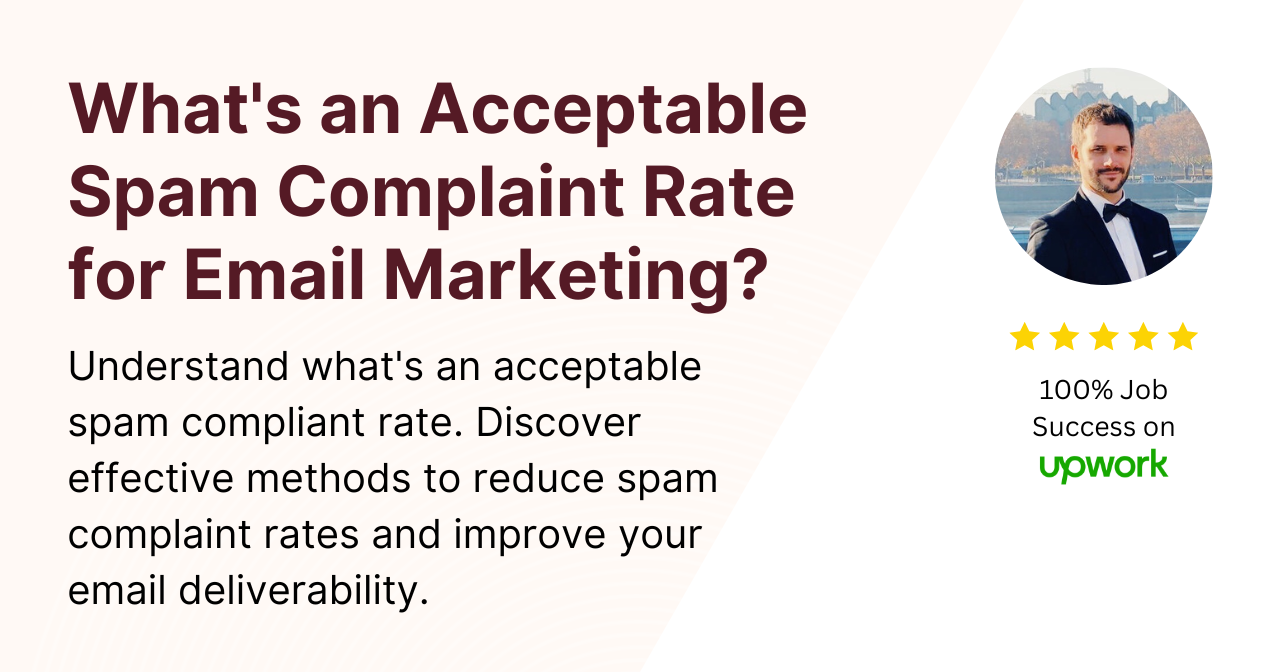Email marketing has become an indispensable tool for businesses to engage with their audiences, promote products or services, and build brand loyalty.
However, amidst the vast ocean of emails that reach inboxes daily, there lies the risk of some recipients labeling emails as spam.
This gives rise to the concept of the “Spam Complaint Rate,” a metric that requires careful attention from marketers.
Understanding Spam Complaint Rate
The Spam Complaint Rate is a crucial email marketing metric that measures the percentage of recipients who mark an email as spam or unwanted.
This rate is calculated by dividing the total number of spam complaints by the number of emails sent, multiplied by 100.
For instance, if 5 recipients out of 1000 mark an email as spam, the spam complaint rate would be 0.5%.
Industry Benchmarks for Spam Complaint Rate
Different industries have varying standards for acceptable spam complaint rates.
However, as a general rule of thumb, a spam complaint rate below 0.1% is considered excellent.
Rates between 0.1% and 0.2% are acceptable, while rates exceeding 0.3% may raise concerns and require immediate attention.
Impact of High Spam Complaint Rate
A high spam complaint rate can have severe consequences for an email marketing campaign:
Deliverability Issues
When ISPs (Internet Service Providers) notice a high spam complaint rate, they might start filtering emails from that sender into spam folders.
This means that even genuinely interested subscribers may miss important messages, reducing the campaign’s overall effectiveness.
Damage to Sender Reputation
A consistently high spam complaint rate damages the sender’s reputation, leading to reduced trustworthiness in the eyes of both ISPs and subscribers.
As a result, future emails from the sender may be flagged as spam even if they comply with all email marketing best practices.
Factors Affecting Spam Complaint Rate
Several factors contribute to the spam complaint rate of an email marketing campaign:
Relevance of Content
If the content of an email is irrelevant or misleading, recipients are more likely to perceive it as spam and file complaints.
Frequency of Emails
Overwhelming subscribers with excessive emails can lead to annoyance and higher complaint rates.
Opt-Out Options
A lack of visible and accessible unsubscribe options can frustrate recipients and prompt them to mark emails as spam.
Ways to Reduce Spam Complaint Rate
To maintain a healthy spam complaint rate, marketers can employ the following strategies:
Segmentation and Personalization
By segmenting the email list and delivering personalized content based on subscriber preferences, marketers can enhance relevance and reduce the likelihood of spam complaints.
Sending Frequency Optimization
Finding the right balance between staying engaged and avoiding email fatigue is crucial in managing spam complaints.
Analyzing engagement metrics can help determine the optimal sending frequency.
Clear and Visible Unsubscribe Button
Including a clear and easily accessible unsubscribe button allows subscribers to opt-out gracefully, reducing the need to mark emails as spam.
Monitoring and Analyzing Spam Complaint Rate
Marketers should utilize available tools to monitor spam complaints effectively.
Analyzing trends and patterns in spam complaints can provide valuable insights to improve email content and engagement strategies.
Conclusion
In the competitive landscape of email marketing, maintaining an acceptable spam complaint rate is vital to ensure successful campaigns and maintain a positive sender reputation.
By prioritizing relevant content, optimizing sending frequency, and offering clear opt-out options, marketers can minimize spam complaints and foster strong relationships with subscribers.
FAQs
What is the primary factor affecting the spam complaint rate?
The relevance of content plays a crucial role in determining whether an email will be perceived as spam or not.
How frequently should I send marketing emails?
The optimal sending frequency varies depending on your audience and the nature of your content. Regularly monitor engagement metrics to determine the ideal frequency.
Can a high spam complaint rate lead to legal consequences?
While a high spam complaint rate can damage your sender reputation, it is not directly associated with legal consequences. However, complying with anti-spam laws is essential to avoid legal issues.
Is it better to have a zero spam complaint rate?
Achieving a zero spam complaint rate is challenging, and a few complaints may be inevitable. The goal is to keep the rate as low as possible through best practices.
How can I track spam complaints?
Various email marketing platforms offer tools to track spam complaints, allowing you to monitor and manage your spam complaint rate effectively.
